If there is any product in the world that makes one nostalgic about Kashmir valley, it is pure Cashmere. Cashmere comes from the mighty ranges of Kashmir. Changthang, a region in Ladakh, is an all-natural ecosystem. Here, perhaps nothing man-made is seen on the first looks of it. Snow-clad mountains, fresh air, arid regions, and plains dry and dirty. Yet nature has blessed this concealed part of the world with a treasure that no developed region in the world can produce; artificially or naturally. It is the gift of Cashmere.
What is Cashmere?
Cashmere is a variety of wool that is obtained from Pashmina goats found in Ladakh. Pashmina goats, also known as Changthangi goats, grow fine, soft, and extremely warm fleece on their bodies. This helps to survive the exceptionally harsh temperature that the region experiences. The fine wool is ethically acquired from the goats and used to make luxury textiles for centuries now. The best and the most famous use of Cashmere is the making of the Kashmiri Pashmina shawl. It is the same shawl that crossed all boundaries of the world to be owned by royal families in Europe, Asia, Australia, and America. The reason was the softness, smoothness, and finesse of the Cashmere fiber which was 1/4th of the human hair in diameter. It began to be used as shawls, apparel, and upholstery items for the royals and their courts.
The most famous use of a Pashmina shawl is its ownership.
by Empress Josephine. When her husband Napoleon came back from a war, he discovered the royal wraps on his way back. He decided to give one to his wife (a Kani Pashmina shawl) as a gift, and she was absolutely fascinated by it. Later it is believed that she ordered a few hundred Kani shawls for herself and her royal acquaintances. All of them were equally pleased and delighted with its utmost finesse, grace, and comfortable feel.
Also read: 7 reasons why women love Cashmere
Where does Cashmere come from?
Cashmere wool is obtained from Ladakh. The nomadic tribal population which resides here in the Changthang region rears a special and rare goat species. The Capra Hircus, also known as Pashmina/Cashmere goat, grows a fine fleece over the sensitive parts of its body. It includes the goat's underbelly, neck and the back of its ears, etc. This wool is Cashmere, but it is still to be processed and sorted as it is right now mingled with thick guard hair. Guard hair needs to be separated for 100% pure Cashmere fibre. Dehaired Cashmere is ready to be further processed, converted to yarn, and later to textile, apparel, or wrap accessories.
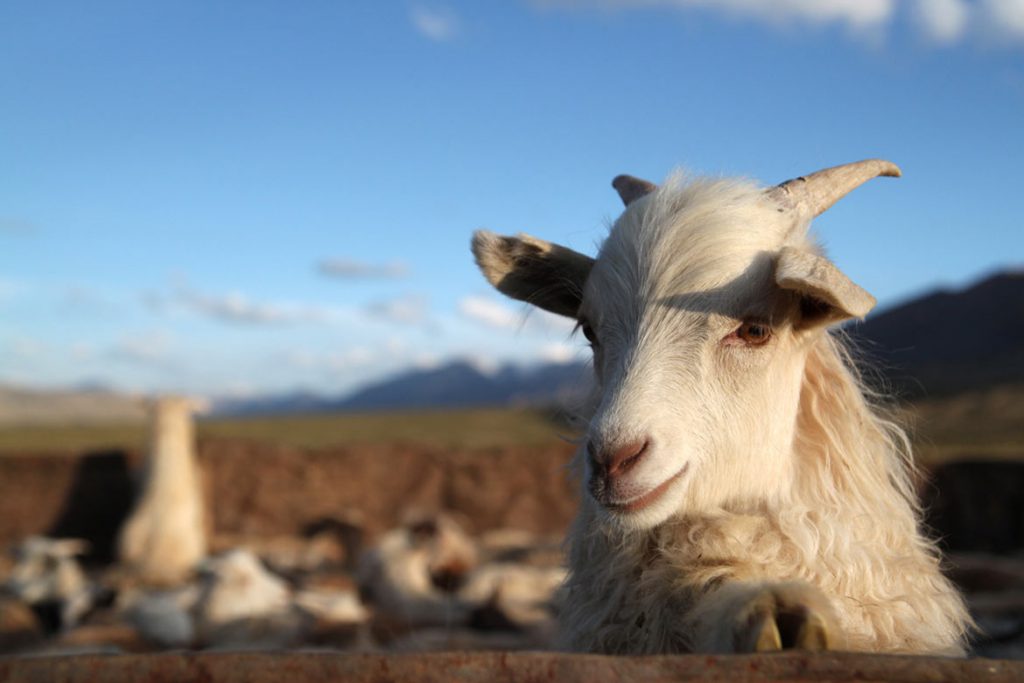
Cashmere is special, to us as well as the goats. The Changthang region witnesses temperatures as low as -40 degrees. The area is isolated and harsh enough to not provide any kind of relief from such cold. Humans live together in small tent-like structures, leaving the goats all alone in the freezing cold. But as they say, nature has its own way to balance things. Cashmere wool growing on the goats is so warm, and they hardly require any other shelter from the cold. It keeps them warm all winter long until their moulting season arrives and they decide to shed this coat naturally.
How is Cashmere obtained?
Cashmere wool is collected during mid-spring when goats tend to shed it naturally. It starts from March end to May. During this time, hormonal changes in the animal force it to shed the wool, and the goat rubs its body with rough surfaces to get rid of some portion of this warm fleece. As such Cashmere remains are found on rough stones, thorny bushes, the floor of their sheds, rough walls, and other nearby areas where the goat has rubbed itself. Herders call for professional help, and specialists arrive with tools, and combs, and other required equipment.
The goat being domestic and well acquainted with the procedure surrenders peacefully to the specialists, and the combing process starts. First, the larger parts like the belly and back are covered and then the smaller areas are combed. The hair, still full of dirt, dust, and foreign material is packed in small pouches which the professionals carry along. It is sent for cleaning.
Also read: The trail of India's Cashmere goat men
Processing of Cashmere
Raw Cashmere wool is sent to Kashmir for further processing where women again clean it. They check for any waste material like vegetable waste, grass, dirt particles, or guard hair and send it for spinning only when they are sure about the purity of the wool. This process takes a few days as perfection is required.
After the cleaning process, Cashmere wool is sent for spinning. This is done by underprivileged womenfolk of the valley who come together from remote areas and work together. Women also have the option to work from their homes and bring their finished material to the required places. For this reason, the art of Cashmere making (Pashmina) has been nearly worshipped by locals, as it has been the source of income for women many centuries ago.
Spinning and Weaving
Women spin Cashmere on a wooden spinning wheel called 'yinder'. The spinning wheel helps to create long threads of Cashmere yarn out of the lump of cleaned wool. The threads are so fine that one can barely see them from a distance. The diameter of these threads is 12 to 16 microns, and are so gentle that they can be broken by a slight moment of the hand. Pashmina threads are now strung together and sent to the factory where large wooden handlooms await. Handlooms are maintained and worked upon by men, as these need extra strength as well as a large space which isn’t possible to create at home
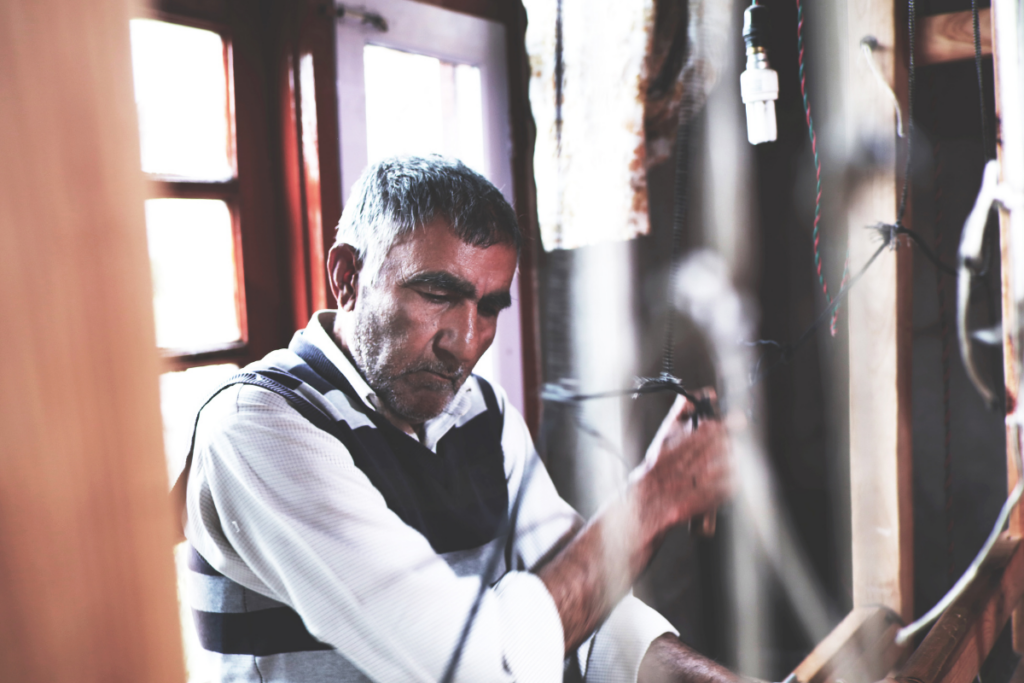
Handloom is used to weave Cashmere yarn and produce fabric. The handloom too is made of wood and is more traditional, than modern. Hence more work is done manually on it. As soon as threads of Cashmere arrive, they are mounted on the loom heddles and two or more workers start with weaving it. One wrap of 100 cm breadth and 200 cm length is done in three to four days, and this is the world-famous Pashmina shawl. It is sent for finishing, embroidery, washing, and ironing, and hence the entire shawl gets ready from early summer to starting winter. It is late September when the sale of these Pashmina starts.
Also read: How warm is Cashmere compared to Merino wool?
The demand for these luxury pieces is always the same. Not just locally, but international sales, too, surge when the season of Pashmina shawls starts. Orders start coming from as far as Europe, and sellers make sure to spread the love of local artisans to the entire world.
Embroidery and Finishing
Solid pieces are ready yet unfinished. These are taken to another group of artisans who give finishing touches to it. These processes include removing extra fibres from the shawl which get attached to it during the weaving process. Cutting of fringes, washing, and ironing the shawl are other practices that are carried out for a better look of the entire shawl.
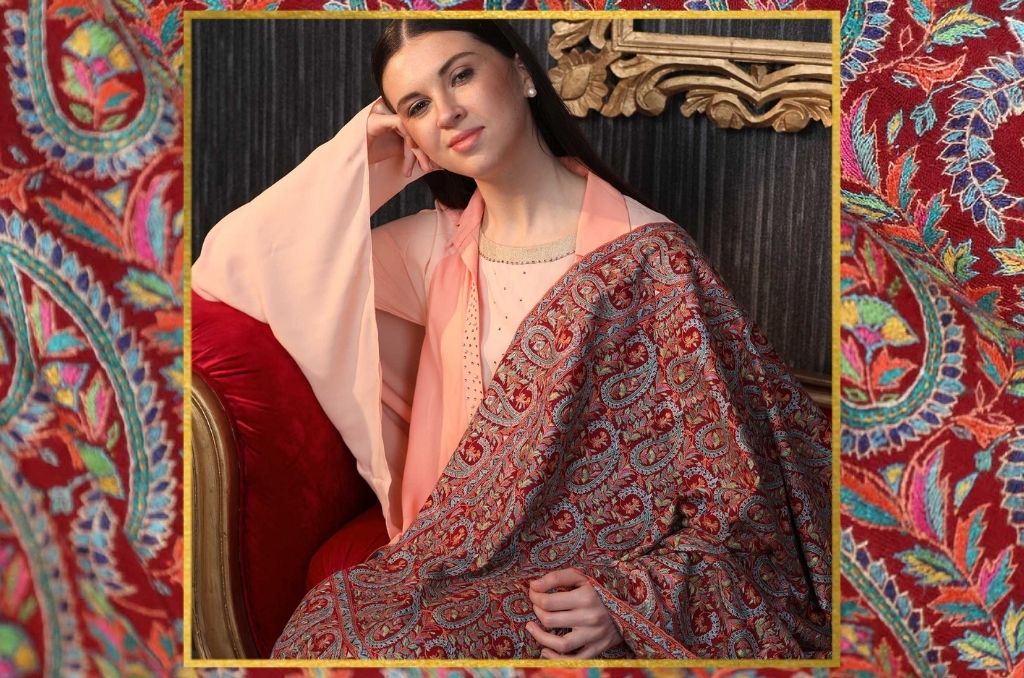
After the solid shawl is ready it is sent for embroidery. A set of artisans, specialists in their work, start embroidering the shawl in a number of patterns and types. A Cashmere shawl takes three main types of embroidery.
Sozni Kari
A fine thread and needle work, which is done all over the shawl, or just its borders. Sozni Kari is the most used embroidery style for Cashmere shawls and scarves. The reason behind the popularity of Sozni is its lightweight and fineness that the delicate Cashmere base can hold. Sozni embroidery artisans make sure to embroider such patterns that do not feel heavy for the fine base underneath. As such Jaalidaar, Jamawar. Botadaar, and Dordaar patterns are the most widely used patterns.
Papier Mache embroidery
A thicker version of Sozni Kari which can be done anywhere in the shawl, including covering the entire base. Shawls, covered in this embroidery, look magically beautiful as the thick and colourful embroidery threads look dazzling over pastel bases of the Cashmere fabric. Papier Mache Shawls are the ones which are at times used as a last piece of wrap for a bride, which she wraps over her head before stepping out of her maternal home.
Tilla Dozi
Tilla Dozi is the royal embroidery pattern which uses metallic threads dipped in real gold or silver to create exquisite patterns over a Cashmere base. It is usually done on the borders of the shawl as the metal thread might pierce through the fine base. Tilla Dozi has been Mughal favourite ever since its inception. Mughal rulers in India used to embellish their furnishings too with Tilla to make it look regal and posh.
After embroidery, the shawl is washed again, sun dried, and ironed. This a final masterpiece is ready to adorn the shoulders of those who have a royal taste of accessorizing.
Also read: 5 must-have Kashmiri Shawls for all times
What is 100% Cashmere scarf?
When the popularity of Cashmere rose to its zenith in the 19th century, many fraudulent traders started making cheap copies. This led to a downfall in the making of pure Cashmere wraps as cheap copies were sold for less. Hence customers got lured toward them.
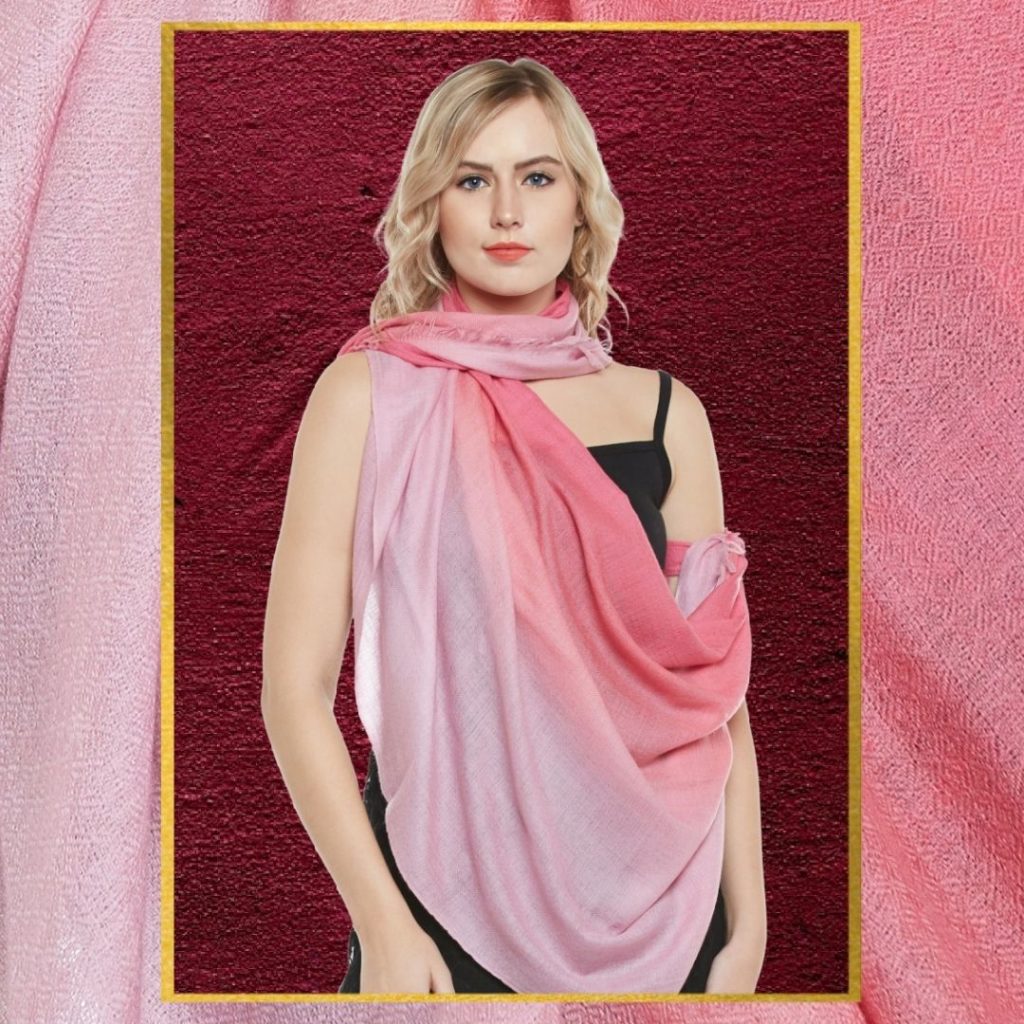
After the advent of power looms, Cashmere wool would be mixed with strengthening nylon or silk to make it eligible for the wear and tear of the machine. The scarves, hence, would be an amalgam of a number of materials and not pure. 100 Cashmere scarf is a 100% pure Cashmere scarf, which is handmade and there is no interference from the machine.
Is Cashmere worth buying?
With a heavy price tag and a single season use mostly, people often ask “Is it worth buying Cashmere, or are we just wasting hard-earned money”? Well, we would suggest buying a Cashmere wrap, because you will be shopping for winter anyway. There are a lot of reasons for that.
Cashmere is rare
Cashmere comes from the Changthangi goat which is a rare species. Some goats producing Cashmere are found in other parts of India and China as well, but Cashmere sourced from this particular goat is the best in finesse and warmth. Again, it takes a wool of 3 to 4 goats to prepare one pashmina shawl, hence adding more its rarity and exclusivity factor.
- The highest quality Cashmere is found in Ladakh. This makes Ladakhi Cashmere rare and worth buying.
- Just a few goats, which are the healthiest, are chosen for Cashmere production, adding more to the rarity factor. Rarity and exclusivity makes Cashmere a luxury product that everyone deserves to experience at least one in their life.
- One goat produces just 150 grams of wool as an average. This makes it even more exclusive.
- The demand for Cashmere is always higher than its supply. This creates a sense of competition amongst buyers making Cashmere one of the most exceptional and unique.
Versatility and Luxury
Cashmere is versatile enough to be worn to your office, a formal lunch with a client, a night out with friends, and attending your child’s school functions. That is because it is lightweight, elegant, and comfortably warm. It has insulating properties, which makes it 8 times warmer than sheep wool, yet extremely breathable and fine. Being unsurpassable soft, and beautiful, this piece well deserves a higher price than its counterparts.
- Cashmere is considered synonymous to luxury. When it comes to Kani Cashmere scarves or Kashmiri Do Rukha Pashmina Shawls, one feels like wearing a piece of art.
- The best quality, handmade Cashmere shawls take years to complete. The final product is just marvellous. This makes it a luxury to own, and a number of women claim to save for months together to own this luxury for once in their lifetime.
- The versatility of Cashmere shawls is unbelievable. These can be used as shawls, as usual, to keep one warm. Other than that Cashmere scarves have been worn as capes, tied to the wearer’s handbag as a bag accessory, used as throws if large in size and even used as baby blankets when temperature dips.
- One can wear Cashmere scarves with ethnic as well as western apparel, given the myriads of patterns it has introduced. Usually, embroidered and Kani wraps are preferred for ethnic outfits while as prints, patterns, swarovski embellished and the like patterns are chosen for western outfits.
Cashmere is timeless
Pure Cashmere, when taken proper care of, lasts for an entire lifetime. For this reason, mothers in Kashmir, give their own Pashmina shawls as gifts to their newlywed daughters as tokens of good luck. And the pieces are sometimes 30 years old. This definitely contributes to the slow fashion drive, which in turn leads to sustainability and betterment of th environment.
- The timelessness of Cashmere is evident from the fact that since its inception in the 15th century, its demand hasn't dropped a bit. Empress Josephine wore it with the same vigour as will a woman today.
- It is absolutely worth buying Cashmere, and we can make it out from the fact that since the 15th century, there has been no changes to the patterns or designs when it comes to embroideries, but still women adore it as much as they did back then
- As many patterns as several dynasties introduced in the making of Cashmere wraps or apparel, none has been lost. Every embroidery pattern, every modern tryst, every new design has been saved. For this reason, the realm of Cashmere making kept expanding, and everyone could find a piece for himself, as if customised. This kept Cashmere in demand continuously
Manual Labour
No stage in processing Pure Cashmere includes mechanical processes. The sourcing is manual, as combing is done to acquire Cashmere from the goat. Then cleaning as well as spinning is manually done by womenfolk. Later weaving, as well as embroidery, is done by men and women without the use of machines. Hence the final result is a product of hard work, meticulous efforts, and the immensely skillful tact that Kashmiri artisans are known to have. Cleaning and spinning take weeks, then weaving another 3 to 4 days, and embroidery takes a few months to a few years depending upon the type and amount of the same to be done.
- It's an uphill climb to prepare large yet fine fabric from lumps of wool that are mixed with immense amounts of dirt and waste when it comes from Ladakh (or any other Cashmere producing region. Transforming those dirt filled sacks to luxury fabric is an art in itself. And Kashmiri artisans are masters of this art
- At times, it takes 4 to 5 years to complete one Cashmere wrap. But never has an artisan complained about the long hauls they spend working on luxury Cashmere shawls. The makers love their work as much as the takers love to wear it.
- If a Cashmere is not made from manual labour, but mechanically, it's truly a waste of an art form. Machines tend to ruin the delicate fibre of Cashmere and in order to retain the same, harsh chemicals are used. These chemicals shorten the life of Cashmere, which otherwise stays for a lifetime.
Sustainable
Cashmere from its acquisition to processing is all sustainable. There is no wastage of the fibre as it is long-lasting, there is no pollution caused because of zero involvement of machines. Besides, Pashmina shawl making is usually done by underprivileged artisans of the valley, and hence this is their only source of income. Therefore if we invest in Cashmere, we will indirectly be helping a household survive. Also, with regards to the sourcing of Cashmere, the process is completely ethical and no animal is harmed during the entire combing process.
- The world of today craves for sustainability. With machines all around causing more harm than good to the planet, something natural is considered out of the ordinary. In these times, Cashmere is something that has a sustainable base. It comes from manual labour and ethical acquisition.
- Sustainability adds to the versatility of Cashmere wraps and shawls. On one hand, it is adored by women who do not care about ethical shopping or responsible buying, and buy Cashmere just for its grace and warmth. On the other hand, careful shoppers and responsible individuals, too, opt for ethically sourced Cashmere, where animal cruelty is nil, labour is manual and employees are treated and paid well.
A gift for those who have everything
We all have a certain friend, colleague, or relative who has almost everything in life. From designer clothes to accessories, they own it all. The problem is when it is their wedding day, or birthday, it is really hard to give them a gift. This is again when Cashmere will help. Kani Pashmina shawl of Kashmir, which takes around 3 to 4 years to complete can be a good gift choice for these extravagance lovers. You can even give them a plain solid black scarf, or a lightly embroidered stole, and delight them with its traditional grace.
Wool from the goat is collected in late Spring to the start of the summer season, as the sale has to start in winter when Pashmina is required. Moulting is season-specific, and processing mills have to wait for an entire year to receive the raw material. Hence the limited production of Cashmere makes it more valuable.
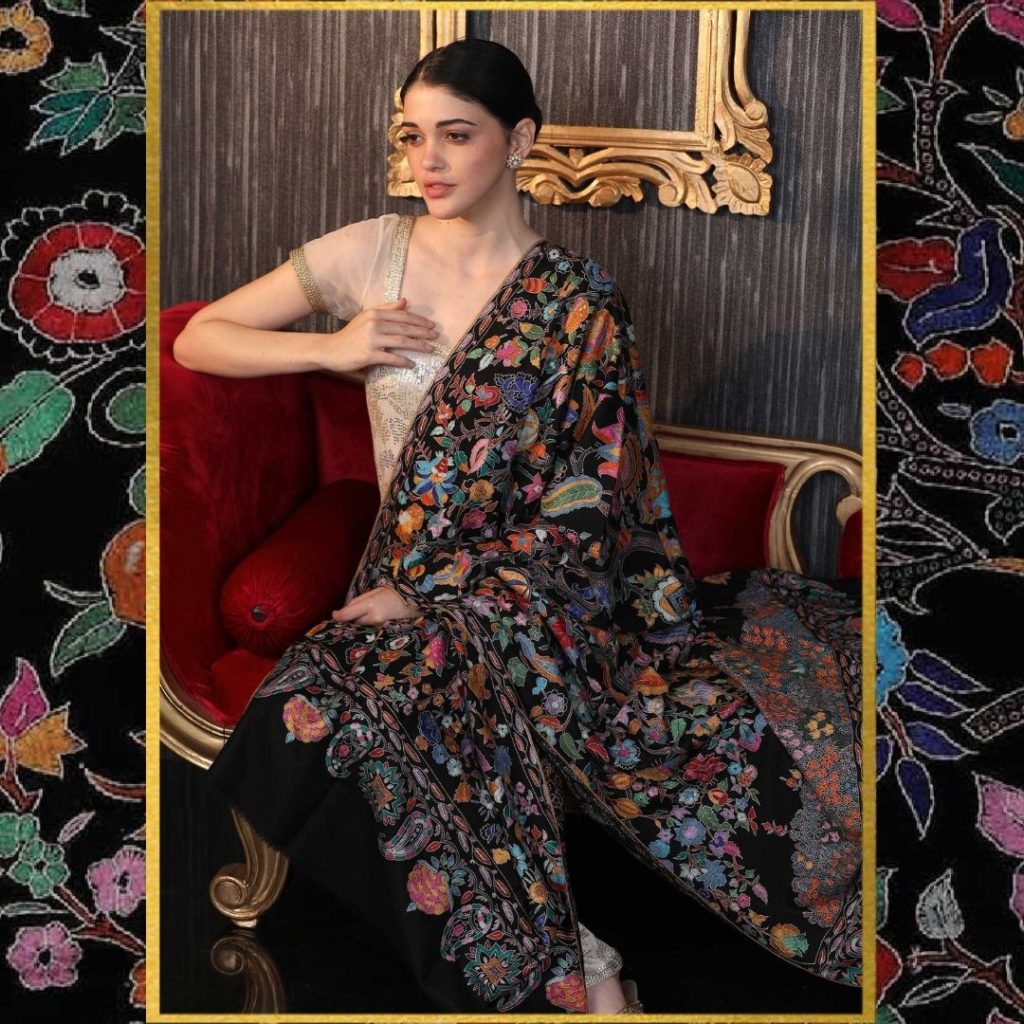
This delay is in turn forwarded to customers, as they too have to wait for a few custom-made shawls to complete. Sometimes elaborate embroidery shawls take 4 to 5 years to complete. As soon as such pieces reach the market, they sell at a quick pace. Hence customers have to keep in mind this demand and be quick in their Cashmere wrap shopping
Rarity, exclusivity, finesse, beauty, and exceptional warmth make Pashmina shawls, and Cashmere wraps, scarves worth every penny spent for them. But the question remains of purity. Always buy pure Pashmina shawls. Ask the vendor for a certificate of purity or look for the GI tag. Make sure your investment is going for the right thing.